Polydactyly (Extra Fingers or Toes) and Corrective Surgery
Hospital for Special Surgery treats many types of congenital hand differences that affect the fingers, including syndactyly and polydactyly.
What is polydactyly?
Polydactyly means “many fingers (or toes)” in Greek, and it is one of the most common congenital limb differences in newborn children. Children with polydactyly are born with one or more extra fingers or toes. These additional fingers or toes can be small nubbins, fully formed extra digits, or anything in between. The extra digit can be next to the thumb/big toe or the pinky/pinky toe or in the middle of the hand or foot. Sometimes, particularly when the extra digit is in the middle, the fingers or toes do not completely separate from each other: This is called synpolydactyly.
What causes polydactyly?
At about four weeks of gestation, the growing human embryo develops four limb buds that will eventually become the arms and legs. At about six weeks, the hands and feet begin to form in the shape of a paddle at the end of the limb buds, which by this point look like little arms and legs. The paddle then develops four clefts, separating the hand paddle into four fingers and one thumb in the hands, or five toes in the feet.

Segmentation and separation of the hand paddle during embryogenesis.
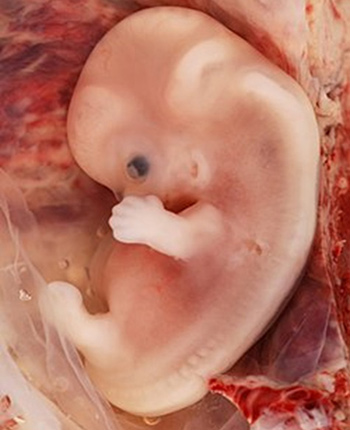
A nine-week old human embryo. Note that the hand paddle has not completely segmented yet and the fingers are formed but still joined. Lower limb development is slightly behind upper limb development. Photo by Ed Uthman.
Occasionally, either because of a random occurrence or because it was genetically inherited, a fifth cleft will develop, creating another finger or thumb, or a sixth toe.
What are the three types of polydactyly?
The three basic types are based on the location of the extra cleft that occurs during fetal development: The extra cleft can be in the middle of the big toe or thumb (“preaxial”), in the middle of the hand (“axial” or “central”), or over the pinky finger or toe (“postaxial”).
If the cleft is on the thumb side of the hand, the material that was to become the thumb will be split into two thumbs. Usually, the more central one is larger and better formed, but occasionally the split will be down the middle and both thumbs will be similar in size and shape. However, both will be smaller than a typical thumb. How early that fifth cleft develops influences how deep the cleft goes. Some thumbs are split at just the bones on the end, whereas others are split all the way down to the base.
Below: Examples of preaxial polydactyly (duplicated thumb).
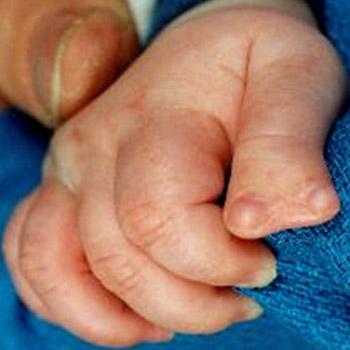
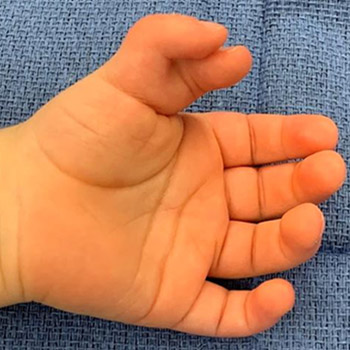

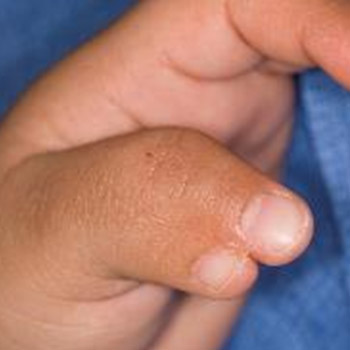
The same is true for an extra digit at the pinky side of the hand. The extra pinky or pinky toe on the outside is usually smaller. Large, extra, postaxial digits are typically associated with genetic disorders such as Ellis-Van Creveld Syndrome. Small nubbins on the pinky side of the hands and feet are also often genetic and common in children with African ancestry.
There are also polydactyly cases known as “mirror hand” or “mirror foot,” in which an entire hand or foot is duplicated, creating numerous extra digits.
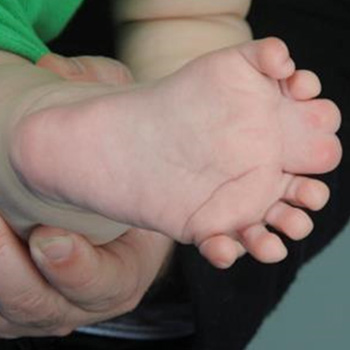
Polydactyly type known as "mirror foot," where the entire foot is duplicated.
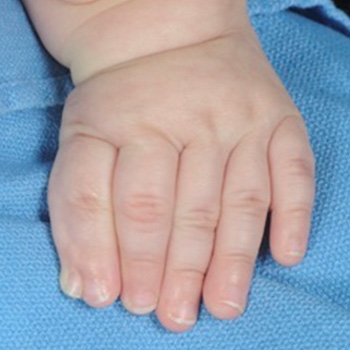
A complex synpolydactyly of the hand, most likely an incomplete "mirror hand."
How common is polydactyly?
Polydactyly is one of the most common congenital limb differences in newborn infants, occurring in about two out of every 1000 live births.1
How is polydactyly diagnosed?
Diagnosis is obvious in the more severe types but, in the thumb, it is sometimes missed if the split just affects the last bone. X-rays are not useful in children younger than one year since, most of the bones have not mineralized yet and are therefore not visible on X-ray. Generally, X-rays are performed only for surgical planning and are done between 18 and 24 months of age. MRI does show the bones, but in patients below the age of eight, an MRI typically requires general anesthesia, and it is not necessary for the diagnosis. The resolution of the MRI is also not sufficient in young children to use in planning treatment in many cases.
How is polydactyly treated?
In simple cases where the extra digit is attached to the hand by a small skin bridge, removal of the extra digit can be done in the office with a cautery device. This can be done within a few days of a newborn’s delivery. It is quick and painless after the initial numbing medicine is applied. Many centers will tie off the extra finger in the nursery, resulting in swelling, redness, and eventually the death of the finger or toe over up to several weeks until it falls off, leaving an often painful nerve stump at the base. We do not recommend allowing this to be done to your child.
Polydactyly surgery
For larger fingers or toes, surgery is recommended. We suggest waiting until the child is at least six months old, or ideally 18 to 24 months of age. Removal of the extra digit is more complicated than just cutting it off. Because some of the parts are shared between fingers or toes, surgery requires moving parts from the digit to be removed into the digit next to it to make the remaining finger or toe function and look better. (Find a doctor at HSS who treats polydactyly of the fingers or toes.)
For example, two thumbs can be combined into one using parts of the nails from both thumbs to get a wider nail and a wider thumb overall.
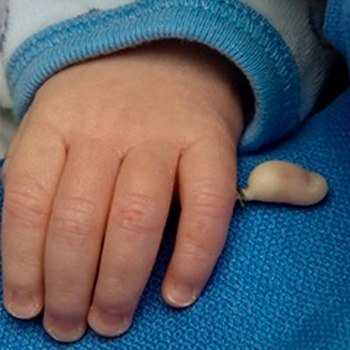
Postaxial polydactyly tied off in the nursery. Notice that the extra finger is white. It will turn black and fall off over the next few weeks. We do not recommend this technique since it is hard for parents to care for and leaves a sometimes-painful lump on the hand once it heals.
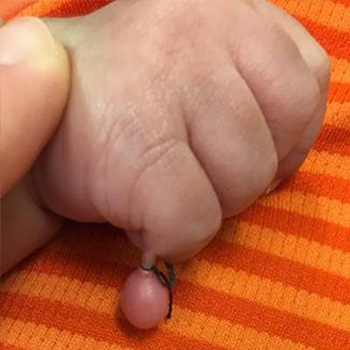
Example of an extra finger having been tied off in the nursery. Note the swelling and redness.
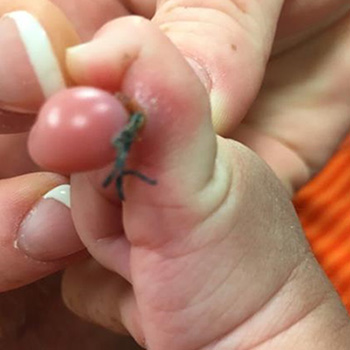
Another example of a finger tied off in the nursery which became painful and infected. We do not recommend this technique.

Tying off a postaxial polydactyly in the nursery can leave an unsightly and painful bump where the extra finger used to be. We do not recommend this technique.
Why are extra fingers removed?
There are three reasons to remove extra fingers:
- They get in the way.
- They cause pain or discomfort.
- They may be unsightly and lead to social and self-esteem problems in the child.
Case example: polydactyly before and after surgery

Postaxial polydactyly with a stiff extra thumb.
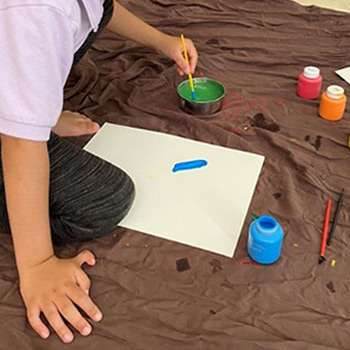
The boy neglected his right hand, preferring instead to use his unaffected left hand.
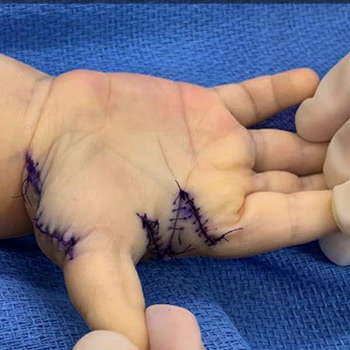
Surgical reconstruction improved the boy's hand function and appearance.
What is the prognosis for polydactyly?
Prognosis is excellent for small extra digits or digits that branch away from a joint, as these can easily be removed. More complicated polydactyly can have good results, but joint motion, stability, and appearance are sometimes a concern. About 30% of patients will require more than one surgery to optimize outcomes.
Posted: 3/8/2023
Authors
Attending Orthopedic Surgeon, Hospital for Special Surgery
Assistant Professor of Orthopedic Surgery, Weill Cornell Medical College
Related articles
Reference
- Azar FM Beaty JH Canale ST Campbell WC. Campbell's Operative Orthopaedics. 14th ed. Philadelphia PA: Elsevier; 2021. 1080-1185.e11. Accessed January 12 2023.
- Wessel LE, Daluiski A, Trehan SK. Polydactyly a review and update of a common congenital hand difference. Curr Opin Pediatr. 2020 Feb;32(1):120-124. doi: 10.1097/MOP.0000000000000871. PMID: 31851054.



